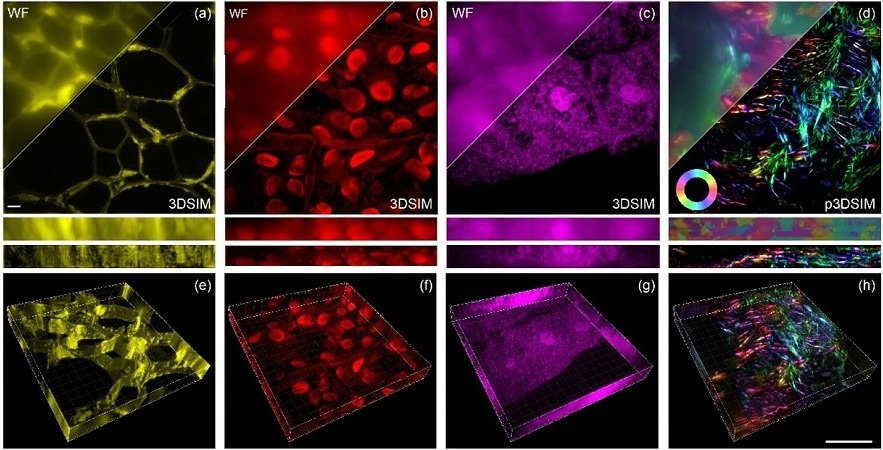In the ever-changing field of microscopy, recent years have seen significant advancements in both hardware and algorithms, accelerating the ability to investigate the small miracles of life. However, the progress toward three-dimensional structured illumination microscopy (3DSIM) has been slowed by difficulties caused by the speed and complexity of polarization modulation.
 Open-source core technology embedded inside projector hardware enables high-speed, auto-polarization modulated 3D structured illumination microscopy (SIM) imaging. 3DSIM reconstruction of plant and animal tissue samples: (a) cell walls in oleander leaves, (b) hollow structures within black algal leaves, (c) root tips of corn tassels, and (d) actin filaments in mouse kidney tissue; corresponding maximum intensity projection (MIP) images are shown respectively in the bottom row (e-h). Scale bar: 2 μm. Image Credit: Li, Cao, et al., doi 10.1117/1.APN.3.1.016001
Open-source core technology embedded inside projector hardware enables high-speed, auto-polarization modulated 3D structured illumination microscopy (SIM) imaging. 3DSIM reconstruction of plant and animal tissue samples: (a) cell walls in oleander leaves, (b) hollow structures within black algal leaves, (c) root tips of corn tassels, and (d) actin filaments in mouse kidney tissue; corresponding maximum intensity projection (MIP) images are shown respectively in the bottom row (e-h). Scale bar: 2 μm. Image Credit: Li, Cao, et al., doi 10.1117/1.APN.3.1.016001
Introducing the DMD-3DSIM System
And now for the high-speed modulation 3DSIM system known as “DMD-3DSIM,” which combines digital display with super-resolution imagery to provide scientists with hitherto unattainable levels of information when it comes to cellular architecture.
According to Advanced Photonics Nexus, the creative arrangement was created by Professor Peng Xi’s group at Peking University using an electro-optic modulator (EOM) and a digital micromirror device (DMD).
With a 3D spatial resolution purportedly double that of conventional wide-field imaging techniques, it addresses resolution issues by significantly improving both lateral (side-to-side) and axial (top-to-bottom) resolution.
Polarized Insight into Cellular Structures
This means that DMD-3DSIM could record fine features of subcellular structures, including animal cell mitochondria, microtubules, actin filaments, and nuclear pore complex.
The applicability of the technology was expanded to include the study of ultrastructures of highly scattering plant cells, such as the cell walls of oleander leaves and the hollow structures found in black algal leaves. The technology demonstrated a strong polarization impact on actin filaments, even in a mouse kidney slice.
An Open Gateway to Discovery
An even more intriguing feature of DMD-3DSIM is its dedication to open science. Xi’s group has enabled cooperation and the scientific community to expand upon this technology by making all of the hardware parts and control systems publicly accessible on Github.
In addition to facilitating important biological discoveries, the DMD-3DSIM technology paves the way for the development of 3DSIM’s next generation.
Improvements in denoising methods, brighter and more photostable dyes, and neural network-based deep learning models hold promise for improving live cell imaging applications in terms of imaging length, information retrieval, and real-time restoration of 3DSIM pictures from noisy data.
Through the integration of open hardware and software, the researchers want to set the stage for multidimensional imaging in the future.
Journal Reference:
Li, Y., et. al. (2023) High-speed autopolarization synchronization modulation three-dimensional structured illumination microscopy. Advanced Photonics. doi:10.1117/1.APN.3.1.016001.